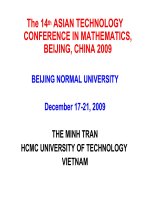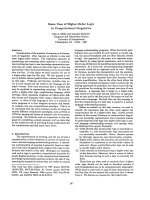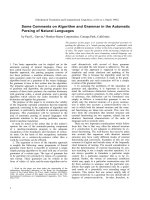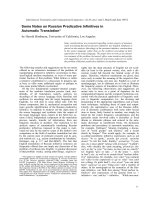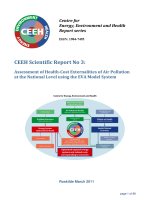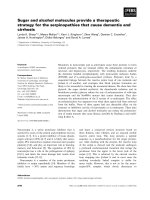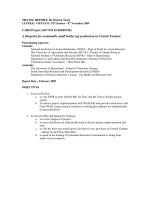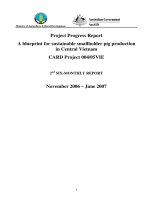Scientific report: "Identify some microorganisms that cause food poisoning in water use in the private slaughterhouses in Hanoi, Vietnam" pot
Bạn đang xem bản rút gọn của tài liệu. Xem và tải ngay bản đầy đủ của tài liệu tại đây (213.3 KB, 8 trang )
J. Sci. Dev. 2009, 7 (Eng.Iss.1): 54 - 61 HA NOI UNIVERSITY OF AGRICULTURE
54
Detection of pathogens causing food borne diseases in
water used
in small slaughterhouses in Hanoi, Vietnam
Xác định một số loại vi sinh vật gây ngộ độc thực phẩm trong nước sử dụng
tại các lò mổ tư nhân tại Hà Nội, Việt Nam
Truong Ha Thai
1
, Yamaguchi Ryoji
2
, Chu Thi Thanh Huong
1
, Nguyen Thi Lan
1
1
Department of Microbiology – Infectious disease – Pathology,
Faculty of Veterinary Medicine, HUA, Vietnam
2
Department of Pathology, Faculty of Agriculture, Miyazaki University, Japan
TÓM TẮT
Nước sử dụng trong hoạt động giết mổ được coi là một trong những nguồn gây nhiễm cho thân
thịt trong quá trình giết mổ, đặc biệt ở các lò mổ tư nhân. Mục đích của nghiên cứu này là xác định
một số loài vi sinh vật gây ngộ độc thực phẩm từ các mẫu nước sử dụng trong giết mổ như
Coliforms, E. coli, Staphylococcus aureus, Salmonella, Clostridium perfringens. Kết quả đã chỉ ra mức độ
ô nhiễm của nước tại các lò mổ này là đáng báo động. Cụ thể, tỷ lệ của mỗi loại mầm bệnh theo thứ
tự nêu trên là 82,50%, 65,00%, 65,00%, 70,83% và 13,33%. Tỷ lệ phân lập được các loại mầm bệnh này
trong các mẫu nước không có sự khác biệt giữa các loại lò mổ khác nhau (lò mổ trâu bò, lò mổ lợn và
lò mổ gia cầm). Kết quả này cũng cho thấy mức độ ô nhiễm vi sinh vật trong nước sử dụng ở lò mổ
cao hơn nhiều lần so với tiêu chuẩn cho phép của Bộ Nông nghiệp & Phát triển nông thôn và một số
tổ chức khác. Nguyên nhân của tình trạng ô nhiễm này là do hoạt động thiếu chuyên nghiệp của công
nhân giết mổ, sai sót trong quy trình giết mổ và điều kiện vệ sinh nguồn nước. Các số liệu được xử
lý bằng phần mềm SAS, phiên bản 8.1 bằng cách chuyển các số liệu sang dạng log
10
, phép thử χ 2 với
độ tin cậy 95%.
Từ khóa: Hà Nội, lò mổ tư nhân, log
10
, mầm bệnh, nước, Việt Nam.
SUMMARY
Water used in small slaughterhouses is considered as one of the sources caused the
contamination for carcass in food processing, especially, in un-hygienic conditions of small
slaughterhouses in Vietnam. In this study, it was aimed at detecting some pathogens from water
samples caused food borne disease such as Coliforms, E. coli, Staphylococcus aureus, Salmonella,
Clostridium perfringens. The results indicated that the contamination level of water collected in
studied slaughterhouses was alarming. In detail, the prevalence of each pathogens mentioned above
was 82.50%, 65.00%, 65.00%, 70.83% and 13.33%, respectively. There was no difference in the
presence of the pathogens among which kind of studied slaughterhouses (p>0.05). The results also
reflected that the level contamination was much higher than the standard provided by the Ministry of
Agriculture and Rural Development (MARD) as well as the permitted norms of other organizations.
Reasons explaining for this situation may rely on the inappropriate activities of workers, the mistakes
in procedures applied in the slaughterhouses and the water sanitary conditions. The data collected
was transformed into log
10
and analyzed by using the SAS software, version 8.1. The prevalence was
compared by χ2-test. All significant differences were determined at CI = 95%.
Key words: Hanoi, log
10
, pathogens, small slaughterhouse, Vietnam, water sample.
Detection of pathogens causing food borne diseases in water
55
1. INTRODUCTION
Maize Nowadays, food safety has become a
major concern in the public health throughout the
world. In Vietnam, this has become a national
problem and needs more research to identify factors
effect on the quality of food in general and meat in
particularly. Many researchers reported that raw
meat (beef, pork, and chicken meat) sold in retail
market in Vietnam was found to be contamination
with pathogens like E. coli, Salmonella,
Staphylococcus aureus, Campylobacter… with
high prevalence and total bacteria in meat samples
exceed the set standard of Ministry of Agriculture
and Rural development (Van et al, 2007; Huong et
al, 2006; Phan et al, 2005). A question was which
source of contamination in meat? Cedric et al, 2006
reported that unhygienic conditions at
slaughterhouses in Hanoi with 88.77% tank water
samples were positive for Salmonella may be one
reason explaining for the contamination in carcass.
Hanoi, the capital of Vietnam with more than 6
million habitants (Laodong, 2008), is facing a high
demand for food supply. In detail, daily meat
consumption in Hanoi is 280 - 300 tons, which
includes 180 - 200 tons of pork (contributing to
around 70% of all meat), 62 tons of poultry meat,
and 40 tons of beef (Vnexpress, 2005). Almost the
meat is processed in private and small
slaughterhouses where the equipments and facilities
are old, inadequate, or found in a desolate condition.
During slaughtering and subsequent meat
processing, the water used for processing becomes a
contaminating source. Follow the standard of
Ministry of Agriculture and Rural development, in
the slaughtering process each cattle, pig and poultry
need 300 to 500 liter of water, 100 liter of water and
30 liter of water, respectively. The quality of water
used for slaughter processes plays an important role
in the transmission of many pathogenic agents
among animal food. Diseases can be transmitted to
human through the animal origins were used water
already contaminated by pathogenic. The aim of this
research was to detect some of the food borne
pathogens which can be originated from water used
in slaughter processing.
2. METHODOLOGY
2.1. Study design
Water samples were collected monthly from
selected small slaughterhouses during a 12 month
period from November 2007 to November 2008 in
Hanoi. The samples were taken from each
slaughterhouse in the early morning before
slaughter processing. There were 3 kinds of
slaughterhouses: slaughterhouses for killing cattle,
pigs and poultry.
2.2. Sample collection and handling
Water sample (200 ml for each sample) was
selected in slaughterhouses aseptically in sterile
containers before processing. Samples (n=120)
were collected monthly and kept with ice and
transported to the laboratory within 2 h of
collection. Do not allow the sample to freeze. All
samples were processed on the day of collection.
Ten – fold serial dilutions were prepared using
sterile 0.8% saline solution and 0.1ml of the
dilution was plated onto duplicate selective agar
plates. The inoculated plates were then incubated at
the desired temperature for the microbial growth.
The results were recorded by calculating colony
forming units (cfu)/ml of the sample.
2.3. Enumeration of bacteria
2.3.1. Enumeration of total anaerobic
bacteria (standard method)
The samples were ten fold serial diluted with
sterile 0.8% saline solution. An amount of 0.1 ml
of each dilution was inoculated into each of 2
disks of Plate Count Agar (PO0158, Oxoid). The
inoculated plates were incubated aerobically at
30
0
C for 24 h.
C
N (CFU/ml) =
(D
n
+ 0.1 x D
(n+1)
) x 10
-n
Note:
N: Total aerobic bacteria per ml of
sample
C: The number of total colonies counted
in 2 consecutive dilutions
n: The first dilution counted
D: Number of disks of each concentration
counted.
2.3.2. Total Coliforms
Using Brilliance E. coli/coliform Selective
Agar (CM1046, OXOID) for the detection and
enumeration of Escherichia coli and Coliforms
water samples. The method for counting Coliforms
was used like the method for counting total bacteria
with purple and pink colonies.
Truong Ha Thai, Yamaguchi Ryoji, Chu Thi Thanh Huong, Nguyen Thi Lan
56
2.3.3. Escherichia coli detection and
enumeration
Continue isolating E. coli form the purple
colonies in Brilliance E. coli/coliform Selective
Agar (CM1046, OXOID) by biochemical tests like
lactose fermentation in 37
0
C/24h, Indol in
45
0
C/24h, VP – MR in 37
0
C/24h. Counting the
number of bacteria by formula above.
2.3.4. Staphylococci detection and
enumeration
0.1ml of each dilution of samples was plated
onto Baird-Parker agar (BPA) (Oxoid Ltd.,
Basingstoke, and Hampshire, England) plates and
incubated aerobically at 37
0
C for 48h.
Representative colonies were Gram stained and
those having the characteristic appearance of
staphylococci counted and expressed as number of
staphylococci/ml.
2.3.5. Clostridium perfringens detection
and enumeration
1ml of each dilution of samples was put into
Liver Broth (Merk). Incubation happened at 37
0
C for
48h. Use tube with gas inside for TSC agar (Oxoid)
and Blood Agar (Merk). Growth bacteria at 37
0
C for
48h anaerobically. Representative colonies black
coloured colonies with opaque halo in TSC and
cause hemolysis in Blood agar were positive.
2.3.6. Salmonella detection
Fresh samples (1 ml) of the tanks water were
pre-enriched using lactose broth and the solution
incubated aerobically at 42
0
C for 24 h. The
samples (1 ml) were then enriched by placing in
selenite cystine and tetrathionate broths (9 ml
each) and incubating at 42
0
C and 37
0
C
respectively for 24 h. Samples were inoculated
onto Xylose-lysine-desoxycholate agar (XLD,
Oxoid Ltd., Basingstoke, Hampshire, England)
and Brilliant green agar (BGA, Oxoid Ltd.,
Basingstoke, Hampshire, England), incubated
aerobically at 37
0
C and examined after 24 h of
incubation. Suspected colonies were inoculated
onto nutrient agar for biochemical tests
(MacFaddin, 2000).
2.4. Data analyse
Counts expressed as colony forming units
(cfu)/ml were transformed into log10 prior to
statistical analysis using the SAS, version 8.1. Data
was analyzed statistically using one way analysis of
variance for each type of microorganism and
differences in counts determined by Fischer’s Least
Square difference test. Prevalence was compared
by χ
2
- test. All significant differences were
determined at P < 0.05.
3. RESULTS AND DISCUSSION
3.1. Enumeration of total aerobic
bacteria
From table 1, it was showed that 100%
samples tested were found aerobic bacteria. The
log
10
mean log
10
SD counted per ml water sample
ranged from 3.92 0.59 in poultry slaughterhouse,
3.97 0.45 in pig slaughterhouse to 4.03 0.55 in
cattle slaughterhouse. However there were not
significant difference about the number of total
bacteria in water in each kind of slaughterhouses (P
= 0.6422). Total aerobic bacteria criteria have been
used to assess the hygiene of processing plants
(Lillard et al., 1984). The contamination caused by
microbial built up as well as the water source.
During slaughtering and subsequent meat
processing, the water becomes polluted by
livestock manure Moreover, in our study, these
slaughterhouses used water from unhygienic water
supply (pond and drill well). Beside, the pipe –
borne water supply used in slaughterhouses could
also be a contamination source of aerobic bacteria
to water because it was always put on the floor and
be used for next times without any clean or
washing methods. One reason was water kept in
tank for a long time without tip.
3.2. Prevalence of Coliforms in water samples
collected from slaughterhouses
Most Coliforms present in intestinal flora of
humans as well as other warm-blooded animals,
and are found in fecal wastes. As a consequence,
Coliforms, which was detected in higher level than
other pathogens, are used as an index of the
potential presence of entero-pathogens in water
environments. The measurement of Coliforms
group has been used extensively as an indicator of
water quality. Historically, the ability to measure
Coliforms in water has translated into the concept
of public health protection. As can be seen from
table 2 that, there was not a remarkable difference
in the prevalence of Coliforms in water in these
slaughterhouses (P = 0.3916 > 0.05). Fecal
Coliforms were detected in almost samples. The
prevalence was 82.5%, 85.0% and 92.5% in
Detection of pathogens causing food borne diseases in water
57
poultry, pig and cattle slaughterhouse, respectively.
The number of Coliforms were counted at a range
of log
10
mean log
10
SD per 100 ml from 2.23
0.26 at pig slaughterhouse and 2.27 0.40 at cattle
slaughterhouse to 2.35 0.40 at poultry
slaughterhouse. The level of Coliforms
contamination in water collected in slaughterhouses
was similar (P = 0.3007 >0.05) with a quite severity.
The number of Coliforms isolated from water in
studied slaughterhouses was higher nearly 4 times
than the Standard of MARD. It reflected that
slaughterhouses were not usually cleaned and
washed carefully in process of slaughter. These
factors created opportunity for feces of animals
contaminated to water through tools and practice of
worker at slaughterhouse.
3.3. Prevalence of E. coli in water samples
collected from slaughterhouses
Escherichia coli is commonly found in
the lower intestine of warm - blooded animals.
Most E.coli strains are harmless, especially,
serotype O157:H7 can cause serious food poisoning
in humans. Common routes of transmission
may include unhygienic food preparation or direct
consumption of sewage-contaminated water.
Among Coliforms group, the specific determination
of Escherichia coli contamination can be performed
as one of the best mean of estimation the degree of
recent fecal pollution (Edberg et al., 2000). The rate
of positive samples with E. coli among 3 kinds of
slaughterhouse was not different (P=0.7716, >0.05).
The rates were 62.5%, 65.0% and 70.0% in cattle,
poultry and pig slaughterhouse, respectively.
However, the level of contamination E. coli was
different (P<0.0001) among slaughterhouses. In
detail, the highest level was in pig slaughters, the
log
10
mean ± log
10
SD per 100 ml was 2.07 ± 0.49.
Following were poultry slaughterhouses (1.75 ±
0.45) and cattle slaughterhouses (1.43 ± 0.30).
There were many opportunities existing at specific
points in the slaughter process for E. coli
transferred from animals as well as intestine’s
content to water such as the level of hygiene, the
dressing procedures and the general condition of
the plant. That may effect on the overall level of E.
coli contamination. Comparison with the Standard
of MARD, the level of E. coli contamination in
water using in slaughterhouses were higher from 10
to 100 times.
Table 1. The result of total bacteria enumeration in water using in slaughterhouse
Variable
No. of
observation
Minimum Maximum Mean ± Std Dev
Cattle slaughterhouse 40 2.30 5.24 4.03 ± 0.55
a
Pig slaughterhouse 40 3.20 4.50 3.97 ± 0.45
a
Poultry slaughterhouse 40 2.48 4.64 3.92 ±
0.59
a
(P= 0.6422)
Table 2. The result of Coliforms isolation in water using in slaughterhouses
Positive sample
Variable
No. of
observation
No. of
sample
Rate
(%)
Min Max Mean ± Std Dev
Cattle Slaughterhouse 40 37 92.50
A
1.11 2.96 2.27 ± 0.40
a
Pig Slaughterhouse 40 34 85.00
A
1.32 2.79 2.23 ± 0.26
a
Poultry Slaughterhouse 40 33
82.50
A
(P=0.3916)
1.56 4.36 2.35 ±
0.40
a
(P= 0.3007)
Truong Ha Thai, Yamaguchi Ryoji, Chu Thi Thanh Huong, Nguyen Thi Lan
58
3.4. Prevalence and enumeration of
Staphylococcus aureus in water samples
collected from slaughterhouses
Staphylococcus aureus is found on human,
environment, dust, air, and sewage normally. The
bacteria can spread primarily by food handlers
using poor sanitary practices. No statistically
significant difference was noted for the prevalence
and numbers of Staphylococcus aureus in water
samples in what kinds of slaughterhouses (P = 0.46
and P = 0.66). This prevalence was ranged from
65.00% at poultry slaughterhouse, 70.0% at cattle
slaughterhouse to 77.5% at pig slaughterhouse.
In this study, Staphylococcus aureus were
isolated from water samples at levels ranging from
log
10
mean log
10
SD 1.43 0.27 (poultry
slaughterhouse), 1.48 0.41 (cattle slaughterhouse)
to 1.50 0.42 (pig slaughterhouse) per ml. This
result was hardly a surprise since workers handle
carcasses with their bare hands. Cross-
contamination of carcasses with S. aureus
constitutes part of the normal flora of the human
hand (Ayc- ic-ek et al., 2004). Enterotoxigenic
strains of S. aureus exist and there is potential risk
of food-borne staphylococcal intoxication. S.
aureus intoxications are often associated with
institutions such as unhygienic slaughterhouses
where animals are often killed in the dirty floor
with unhygienic water supplies. While heat
processing and normal cooking temperatures are
sufficient to kill the bacterial cells, the enterotoxins
are stable and not inactivated. The appearance of
Staphylococcus aureus in water may be transferred
to the carcass, therefore, can not ensure that food
from animals which were killed in these
slaughterhouses is safe.
Table 3. The result of E. coli isolation in water using in slaughterhouse
Positive sample
Variable No. of observation
No. of sample
Rate
(%)
Min Max Mean ± Std Dev
Cattle
Slaughterhouse
40 25 62.50
A
1.01 2.51 1.43 ± 0.30
c
Pig Slaughterhouse 40 28 70.00
A
1.19 2.86 2.07 ± 0.49
a
Poultry
Slaughterhouse
40 26
65.00
A
(P=0.7716)
1.10 2.58 1.75 ±
0.45
b
(P <0.0001)
Table 4. The result of Staphylococcus aureus isolation in water using
in slaughterhouses
Positive sample
Variable
No. of
observation
No. of
sample
Rate
(%)
Min Max Mean ± Std Dev
Cattle Slaughterhouse 40 28 70.00
A
0.63 2.51 1.48 ± 0.41
a
Pig Slaughterhouse 40 31 77.50
A
0.88 3.20 1.50 ± 0.42
a
Poultry Slaughterhouse 40 26
65.00
A
(P=0.4647)
0.64 1.94 1.43 ±
0.27
a
(P= 0.6643)
Detection of pathogens causing food borne diseases in water
59
3.5. Prevalence of contamination Salmonella
spp in water samples collected from
slaughterhouses
Salmonella
Salmonella is one of major causes food-borne
illness throughout the world. The bacteria is
generally transmitted to human through
consumption of contaminated food of animal
origin, mainly meat and poultry. The symptoms of
Salmonella infection usually appear 12 - 72 hours
after infection, including fever, abdominal pain,
diarrhea, nausea and sometimes vomiting. The
results of Salmonella isolation in water using in
slaughterhouse were represented in table 5.
Salmonella was isolated from 85 out of the 120
samples tested (70.83%). No significant difference
was found among in what kinds of slaughterhouses
(P = 0.5919 >0.05). The prevalence of
contamination Salmonella spp detected from water
in poultry slaughterhouse, pig slaughterhouse and
cattle slaughterhouse were 65.0%, 72.0% and
75.0%, respectively. The higher prevalence of
Salmonella infection of water in pig slaughterhouse
(88.77%) was reported by Cedric et al. (2006).
Large commercial processing plant may be
explained for higher prevalence of contamination
Salmonella in this research.
In fact, there has been no Standards for
Salmonella criteria in water using in slaughterhouse
in Vietnam. However, following the Standards of
MARD, establishes guidelines for microbiological
contamination in fresh meat: Salmonella should be
absent in 25 g of sample. Consequently, nobody
can ensure that no carcass or fresh meat
contaminated by Salmonella before it’s comes to
consumer with prevalence of Salmonella infection
in water at slaughterhouses above.
3.6. Prevalence of Clostridium perfringens
in water samples collected from
slaughterhouses
Clostridium perfringens
Clostridium perfringens are Gram-positive,
anaerobic sporeforming rods. They are widely
distributed in the environment and frequently
occur in the intestines of humans and many
domestic and feral animals. The spores are
capable of surviving in soil, sediments and areas
subject to fecal contamination. The spores are also
extremely heat resistant and have been reported to
survive boiling for several hours. Contaminated
meat is usually responsible for outbreaks of
Clostridium perfringens food poisoning. In this
study, Clostridium perfringens were detected
16/120 samples tested (13.33%). There were not
remarkable difference of the prevalence of
Clostridium perfringens in water samples
collected (P = 0.6036 > 0.05). This prevalence
were from 10.0% in poultry slaughterhouse to
17.50% at cattle slaughterhouse. And as regards to
pig slaughterhouse, the rate was 12.50%. These
results reflected that there was contamination
from feces of animals to water at slaughterhouses.
The results obtained here indicated that
microbiological contamination of water in the
slaughterhouses in Hanoi was high. The water
was contaminated with both anerobic bacteria
like Clostridium perfringens and aerobic bacteria
such as Salmonella, E. coli, Staphylococcus
aureus. These bacteria are considered a risk to
human health. Practice in slaughterhouse may
explain for the high prevalence of bacteria
isolated in Vietnam. At slaughterhouse, animals
were slaughter in the floors which was very
dirty. In addition, viscera were also done in this
place because almost slaughterhouses in Vietnam
were not divided to separated areas for each
production chain. Cross-contamination bacteria
from feces, sewage in the floor to water may also
have occurred as a result of using the tools or
basin to take water in the tanks and then put
these tools in the dirty floor. These tools will be
used for the next time without clean or
disinfection. Beside, animals were carried from
different sources, a part of them were not kept in
quarantine by veterinarian. Moreover, at
slaughterhouses, animals were usually killed
when they were dirty, hungry and thirsty.
Therefore, when Ministry of Agriculture and
Rural Development (MARD) mission visited one
of these slaughterhouses in Hanoi, the leader had
said that “This area only is gathered for slaughter
and not slaughterhouse” because both of inside
and outside of this area were very dirty and
unhygienic. These processing plants cannot
guarantee that whether the products will be free
of bacterial pathogens, ever effort must be made
to decrease the incidence of pathogens and
therefore reduce the potential risks for the
consumers.
Truong Ha Thai, Yamaguchi Ryoji, Chu Thi Thanh Huong, Nguyen Thi Lan
60
Table 5. The prevalence of Salmonella in water using in slaughterhouse
Positive sample Negative sample
Variable
No. of
observation
No. of samples
Rate
(%)
No. of samples
Rate
(%)
Cattle Slaughterhouse 40 30 75.00
a
10 25.00
Pig Slaughterhouse 40 29 72.50
a
11 27.50
Poultry Slaughterhouse 40 26 65.00
a
14 35.00
Total 120 85
70.83
(P=0.5919)
35 29.17
Table 6. Test results of Clostridium perfringens isolation in water using
in slaughterhouse
Positive sample Negative sample
Variable
No. of
observation
No. of
samples
Rate
(%)
No. of
samples
Rate
(%)
Cattle Slaughterhouse 40 7 17.50
a
33 82.50
Pig Slaughterhouse 40 5 12.50
a
35 87.50
Poultry Slaughterhouse 40 4 10.00
a
36 90.00
Total 120 16
13.33
(P=0.6036>0.05)
104 86.67
4. CONCLUSION
The quality of water using in slaughterhouses
in Hanoi, Vietnam was alarmed. Detection some
pathogens caused food borne disease from these
water samples indicated that the prevalence of
these bacteria was much higher than the set of
Standard. Especially, the rate of Salmonella and
Clostridium perfringens were high compare to the
Negative Requirement of Standard. The main
reasons of the situation were activities and
practice of workers in slaughterhouses as well as
the sanitary condition in slaughterhouses. This
problem may lead the contamination for carcass
and from that it will be the source of food borne
diseases.
Acknowledgement
The present studies were supported by the
special fund of Hanoi University of Agriculture for
young researchers. The author would like to thank
the students and technicians who help with sample
collection and processing and colleagues at
Miyazaki University for their helps. We also thank
to the hosts of slaughterhouses and individuals
participated in this study who offered us great
cooperation in our field collection. We would like
to express our deep gratitude to them for their
kindness and helps.
REFERENCES
Aycicek, H., Aydogan, H., Kucukkaraaslan, A.,
Baysallar, M., Basustaoglu, A.C., (2004).
Assessment of the bacterial contamination on
hands of hospital food handlers. Food Cont. 15,
253–259.
CDC (Centers for Diseases control and
Prevention)., January, 10, (2005).
/>odborneinfections_g.htm#howmanycases.
Detection of pathogens causing food borne diseases in water
61
Cédric Le Bas, Tran T. Hanh, Nguyen T. Thanh,
Dang D. Thuong, Ngo C. Thuy., (2006).
Prevalence and Epidemiology of Salmonella
enterica subsp. enterica in Small Pig Slaughtering
Units in Hanoi, Vietnam. Annals of the New York
Academy of Sciences 1081: 269-272.
Edberg, S.C., Rice, E.W., Karlin, R.J., Allen, M.J.,
(2000). Escherichia coli: the best biological
drinking water indicator for public health
protection. Symp. Ser. Soc. Appl. Microbiol. 29,
106S– 116S.
Huong. L. Q; Fries Reinhard; Padungtod Pawin;
Hanh T. T; Kyule Moses N;
Baumann Maximilian P. O; Zessin Karl H.,
(2006). Prevalence of Salmonella in retail
chicken meat in Hanoi, Vietnam. Annals of the
New York Academy of Sciences ISSN 0077-
8923, vol. 1081, pp. 257-261.
MacFaddin, J.F., (2000). Biochemical tests for the
identification of medical bacteria. 3rd ed.
Lippincott Williams and Wilkins, Philadelphia.
Ngọc Phương., (2008). Bộn bề "bức tranh" dân số
Hà Nội (mới). Báo Lao Động.
Như Trang., (2005). Tranh cãi về địa điểm xây dựng
4 cơ sở giết mổ gia cầm hiện đại.
/>9E51B0/
Phan, T. T., L. T. Khai, N. Ogasawara, N. T. Tam,
A. T. Okatani, M. Akiba, and H. Hayashidani.,
(2005). Contamination of Salmonella in retail
meats and shrimps in the Mekong Delta,
Vietnam. J. Food Prot. 68:1077–1080.
Samuel, J.L., O'Boyle, D.A., Mathers, W.J., Frost,
A.J., (1980). Distribution of Salmonella in the
carcasses of normal cattle at slaughter. Res. Vet.
Sci. 28, 368-372.
Standard Code and Protocol for Veterinary
(Veterinary Hygience and Food Safety) (2007).
Department of Animal Health (DAH), Ministry
of Agriculture and Rural Development (MARD),
Agriculture Publication, Hanoi.
Thi Thu Hao Van, George Moutafis, Taghrid
Istivan, Linh Thuoc Tran, and Peter J. Coloe.,
(2007). Detection of Salmonella spp. in Retail
Fresh Food Samples from Vietnam and
Characterization of Their Antibiotic Resistance.
American Society for Microbiology, Vol. 73, No.
21, p. 6885-6890.


